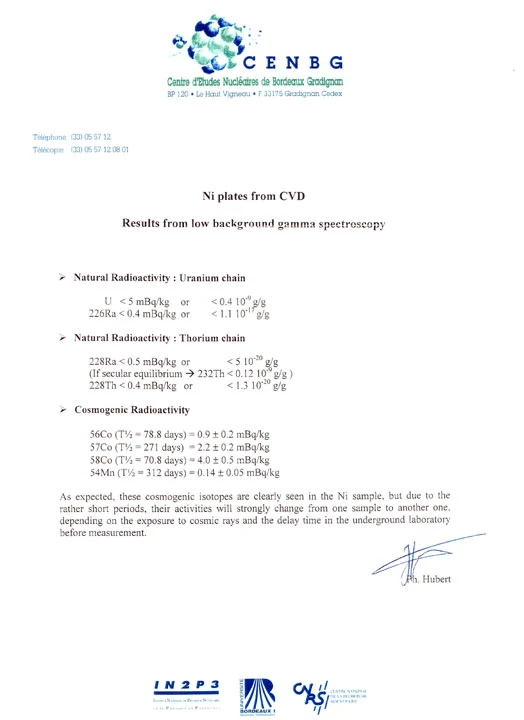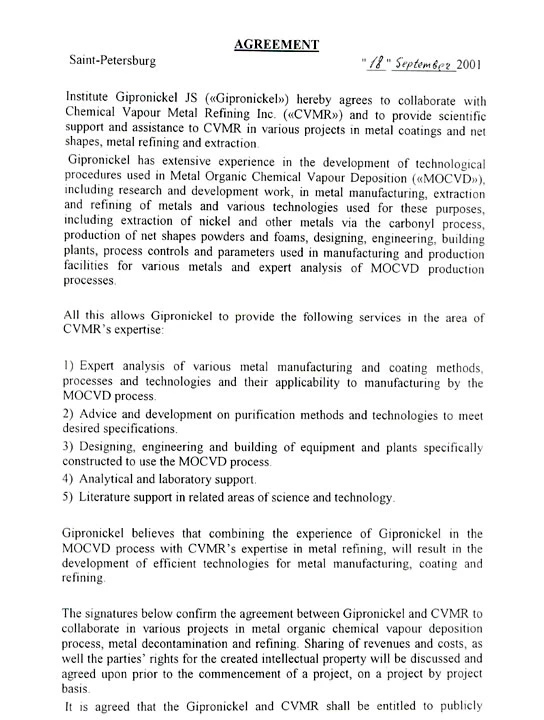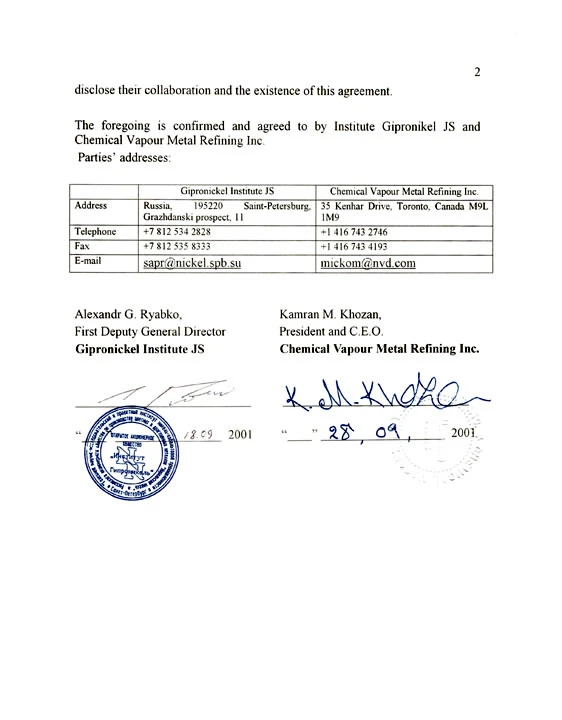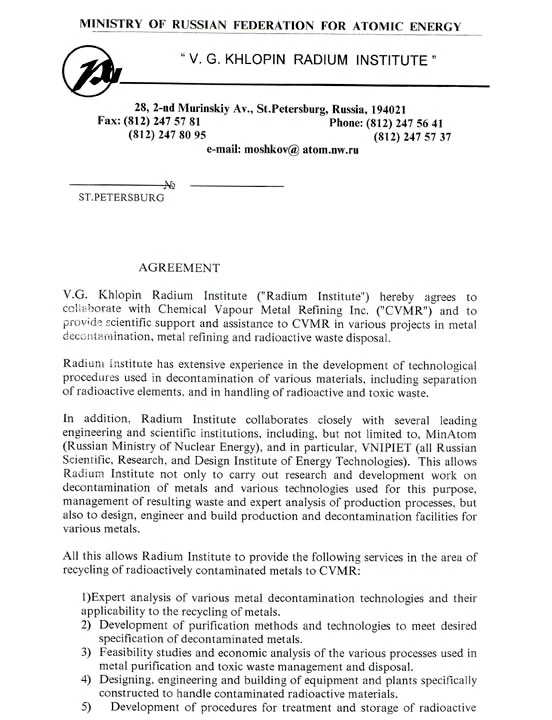References & Publications
-
REFERENCES FOR THE CVMR® PROCESSES FOR REFINING, PURIFICATION AND DECONTAMINATION OF METALS BY VAPOUR METALLURGY
-
fiber_manual_recordCanadian Department of National Defence reference letter, supporting the technology and processes of CVMR® for work in the refining and purification of base metals (e.g. nickel, tungsten, molybdenum etc.) and platinum group metals.
![]()
-
fiber_manual_recordThe findings from the Centre d'Etudes Nucléaires de Bordeaux Gradignan physical testing laboratory in France, showing the extremely low level of contaminants in metal produced by CVMR®'s vapour metallurgy processes.
![]()
-
fiber_manual_recordLetter of agreement for cooperation between CVMR® and Gipronickel of Russia (the Research division of Norilsk Nickel) for the exchange of scientific and technical information, relating to vapour metallurgy and carbonyl technology. Thumbnail imageird
![]()
![]()
-
fiber_manual_recordLetter from University of Washington, USA identifying the extreme purity of nickel parts made for the Sudbury Neutrino Observatory, a multi-national scientific research project with the US Department of Energy's Division of Nuclear Physics.
![]()
-
fiber_manual_recordLetter of agreement for cooperation between CVMR® and the Radium Institute of Russia at St. Petersburg, on matters of decontamination of metals related to nuclear energy processes.
![]()
![]()
-
PUBLICATIONS
-
fiber_manual_recordO'Meara, M F.: "Recycling Metals Using the Metal Organic Chemical Vapour Deposition Process" at the Fourth International Symposium on Recycling of Metals and Engineered Materials. (TMS fall 2000 Extraction and Process Metallurgy Meeting, Pittsburgh).
RECYCLING METALS VIA MOCVD PROCESS
Mick O'Meara
ABSTRACT:
Metal Organic Chemical Vapour Deposition (MOCVD) process is used for the production of computer circuit boards and metal shapes in nickel, gold, copper, cobalt, etc. All varieties of the MOCVD process use decomposition of a vapour of organometallic compounds to produce different forms of pure metals, or metal alloys. CVD Manufacturing's proprietary MOCVD process has been adapted and developed to produce ultra-pure metal shapes, metal powders or metal foams. The typical process, for re-cycling and purification of contaminated metals, consists of three steps. The first step is the production of a volatile metal organic compound from metals, metal oxides, etc., which are volumetrically contaminated. The typical feed material is a metal powder, ore, concentrate, or a slurry of metals and contaminants. The second step is the purification of the volatile metal organic compound by fractional distillation. The final step is the decomposition of purified metal organic compound into different forms of ultra-pure metal such as net shapes, metal powders or metal foams. A mixture of metals can be purified by the selective production of volatile materials. Alternatively, a separation can be achieved during the second step, in the fractional distillation stage to separate the metals. -
fiber_manual_record"Chemical Vapour Metal Refining (CVMR®) of Platinum Group of Metals (PGM)" Sergey N. Kovtun, Mick F. O'Meara, Nanthakumar Victor given at the Australian Institute of Mining and Metallurgy Conference, 2002, Sydney NSW.
CHEMICAL VAPOUR METAL REFINING (CVMR®) OF PLATINUM GROUP OF METALS (PGM)
Sergey N. Kovtun, Mick F. O'Meara, Nanthakumar Victor.
ABSTRACT:
The current extraction method of the Platinum Group of Metals (PGM) from an ore concentrate and the subsequent separation of one PGM metal from another is a time-consuming complicated multi-step process. The use of the Chemical Vapour Metal Refining (CVMR®) process for the extraction and separation of PGMs is a simple and economical alternative. The paper covers the CVMR® process, which is based on the formation of volatile metal compounds, followed by extraction and thermal decomposition into the pure metals and reagent gases. In the case of PGMs, CVMR® does not use CO, and hence, the process is quite different from the carbonyl process previously attempted by a number of organizations and test facilities. CVMR® extracts PGMs via synthesis of trifluorophosphine complexes at low pressures and low temperatures (80 to 100 oC). These two facts alone make the process highly economical, compared to other methods available. This paper presents a comparison between the process of extraction of PGM's and CVMR® proprietary carbonyl process for the extraction of nickel and cobalt. In the carbonyl process, CVMR® also uses very low pressures and temperatures, compared to varies other processes currently used. -
fiber_manual_recordAugust 2006:"Use of CVMR®'s Technology on Mars" Paper presented to a NASA sponsored conference on potential technologies for moon and mars exploration and development, in Washington DCAbstract of Paper presented to NASA Conference in Washington DC August 2006: "Use of CVMR® Technology on Mars" (Presented by CVMR®, Research & Development Department.)
Chemical Vapour Metal Refining (CVMR®) is a process of extraction and refining of metals from ore, ore concentrates or recycling materials. The CVMR® process was developed, in its basic form, at the beginning of the 20th century. At present, more than 20% of worldwide annual nickel production is refined using carbonyl technology, a variety of CVMR® process. Carbonyl technology (the Mond process) is a vapour metallurgical refining method based on the ability of nickel, iron, cobalt, etc. to form volatile metal carbonyl compounds. Carbonyl process was suggested as the best method of refining metals on Moon and Mars. We propose to combine metal refining and production of metal parts in the same process. As part of CVMR®’s research for production of high value products (powders, foams and net shapes) from nickel, we have developed a self-contained unit capable to perform extraction of metals and manufacturing metal net shapes at the same time. What is missing, is a carrier to deliver an adaptation of such unit to the other heavenly bodies to begin mining and production of metal structures. In this presentation we review the feasibility of usage of self-contained units to space mining, including the chemistry and engineering challenges. The presentation emphasizes extraction of base metals such as Fe and Ni and production of iron or stainless steel structures in situ. The paper also reviews an application of CVMR® technology to other metals.
Click here to access the full presentation -
fiber_manual_recordRecycle of Zirconium from Used Nuclear Fuel Cladding:A Major Element of Waste Reduction - 11336
-
fiber_manual_recordViews on Practical Approaches to Recycling Used Fuel







